

If you give a novice a threaded machine in addition to different types of fabrics and you tell them to sew, chances are they’ll use whatever needle that’s already on the machine for all fabrics. However, if you’re more informed, you’ll know this can lead to all kinds of problems in your project. A few examples include skipped stitches, broken threads, broken needles, ruined fabric, tension problems, and more.
Consequently, it’s essential to always ensure you’re using the right sewing machine needle sizes and types. That said, the numerous needle sizes available can make it more challenging to determine which option to use. As such, something like a sewing machine needle guide like the one below can come in handy. In addition to telling you about the sizes, the guide below also covers several other factors determining what each needle can be used for, so keep reading.
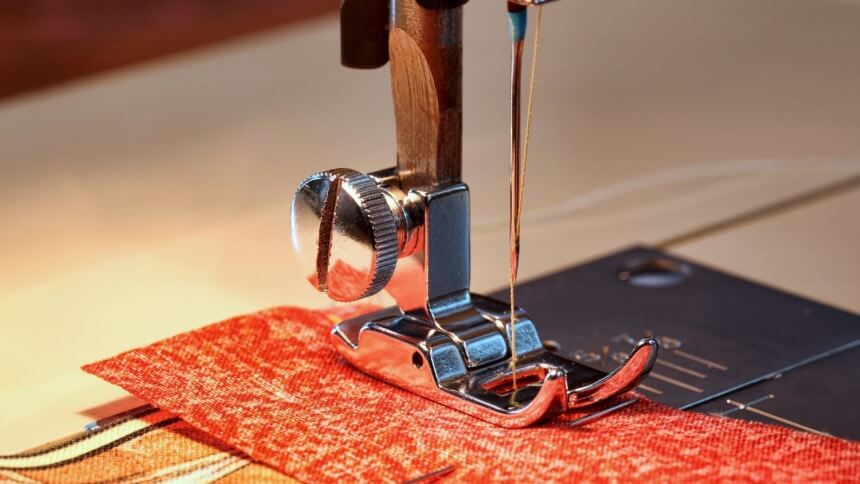
As for the European numbers, it’s fairly easy to correlate that with needle sizes. For instance, the 110 example given above is for a 1.1mm diameter needle. A 90 size needle, on the other hand, has a diameter of 0.9mm. As you can see, the smaller the number, the thinner the needle.
Also, when it comes to Kenmore, Singer, or Brother sewing machine needle sizes, they help determine the size of threads for the different projects. For instance, the smallest needles can accommodate the finest threads, while the largest needles can accommodate much thicker threads. Of course, you can use thin threads with thick needles and thick threads with thin needles, but that usually only leads to more problems.
In the section above, we mentioned the shaft, which is only one part of the needle. Of course, as a sewing enthusiast, you should be familiar with not only the shaft but also other components of the needle.
It comes with a thick semi-rounded design at the top. This thick part is what is referred to as the shank. It has a rounded front and a flat backside. This helps position the needle the right way whenever you add a new one to your sewing machine. Just below the shank, you find the shaft, a round component that’s a lot thinner.
As you go down the shaft, you come across a groove followed by a scarf. The scarf is a smaller groove-like structure that leads into the eye of the needle. This component enables the machine’s hook to get as close to the eye of the needle as possible. As such, it helps avoid skipped stitches. After the eye, the needle tapers into a point or what’s referred to as the sharp tip of the needle.
Notably, when determining the sewing machine needle sizes and uses, the types of sewing machine sewing needles also come into play. After all, there are three main needle types as well as a few other specialty options. The three main options are the universal point needles, ball-point/jersey needles, and sharps/ sharp point/ Microtex needles.
Universal point needles, as the name suggests, are the closest thing you’ll find to all-purpose needles. They come with a slightly rounded tip and seemingly work for most woven and knit fabrics. If your new sewing machine comes with a needle set, then it’s likely that at least one of those needles is a universal point option.
Notably, SCHMETZ remains the most popular brand, especially where sewing machine needles are concerned. Their Universal Sewing Machine Needle set contains 50 needles that fit all household sewing machines, including Brother, Singer, Janome, and some unique options like Baby lock and Bernina.
As for ball-point needles, they live up to their name and feature rounded points. This allows them to slip between the loops in knit fabric as opposed to breaking through them. Notably, breaking or piercing through some knit fabrics can have negative consequences, e.g., skipped stitches or fabric damage.
Microtex needles, on the other hand, have the sharpest points of the three. They’re great for high-density or heavyweight woven fabrics since the sharp points ensure minimal resistance as they pierce through. Furthermore, they work well for top-stitching, especially if you’re layering the fabrics. As for the other specialty needles that you might encounter, they’re as follows:
Given that some fabrics are stretchy, using the same needles as you would on normal fabrics is a recipe for disaster and often leads to skipped stitches. This is also why there are stretch needles. They look a lot like ball-point needles, although their design also features a slightly less rounded tip. Additionally, they come with a modified eye and scarf, and these components allow the hook an easier time while picking up the top thread. Overall, they are perfect for stretch fabrics like rib-knit, spandex, or elastane Trusted Source What Is Elastane, and Is It Sustainable? Elastane, also known as spandex, is an incredibly common fiber. Discover its properties and why it doesn’t rank high on our sustainable scale. www.treehugger.com .
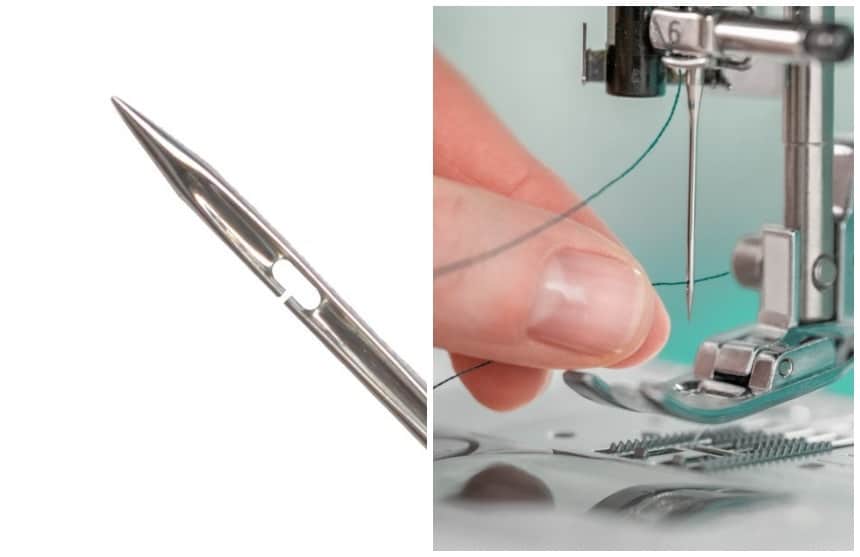
Top-stitching typically requires thicker threads since you want them to be visible for decorative purposes. As such, top-stitch needles are designed to cater to that need. This is why they have extra-large grooves and extra-large eyes compared to other needle types. Furthermore, they also often have to pierce through multiple pieces of fabric, so it helps that they have sharp points.
Hemstitching Trusted Source What is a Hemstitch? A hemstitch is a type of ornamental stitch that is sewn at the hem of a piece of fabric or garment. The way to make a hemstitch… www.wise-geek.com is basically a decorative hand sewing technique. It’s typically used alongside hems and involves pulling out adjacent threads and then tying them into bunches, resulting in a row of small holes in your fabric. This effect can also be mimicked by a machine hemstitch needle. The needles feature a wing/wide blade design on each side which cuts the decorative groove in the fabric.
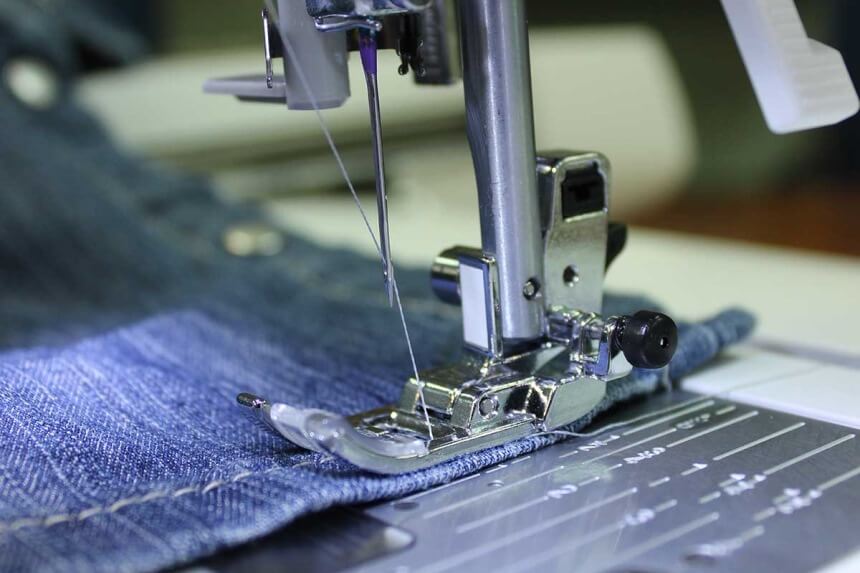
Leather is one of the toughest materials available, and as such, the needles also have to be strong. However, they also have to fulfill other criteria to be fit for the job. For example, they come with a wedge-shaped design that’s quite similar to an arrowhead. This design allows them to pierce the material without causing significant damage. That said, if you were to use such a needle on other woven or knit fabrics, you would ruin the materials.
As for metallic needles, they’re made with metallic and other specialty threads in mind. This is because such threads tend to break more often when used with regular sewing needles. However, with the elongated eyes that reduce friction between the thread and needle, there is a significantly reduced breakage rate.
Some embroidery threads are quite delicate and therefore at a higher chance of breakage when used in an embroidery machine. Furthermore, there’s the possibility of missed stitches due to the rapid flexing of the fabric during the embroidery process. That said, embroidery needles are designed to counter these issues. They have wider eyes that the delicate threads can pass through freely without much friction. Additionally, the pontoon scarf and medium-sharp point help reduce the flexing motion in the fabric as you work.
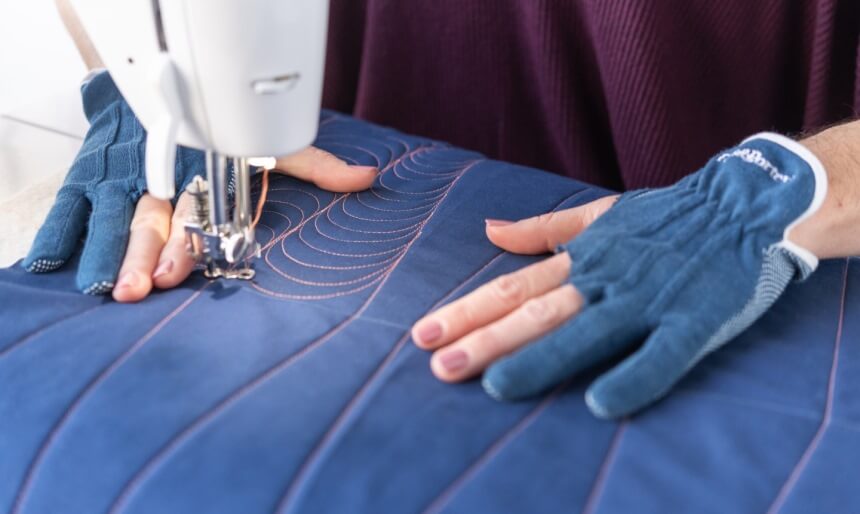
The design of a twin needle is unique since it features a single shank while the rest of the components are in twos. This includes two shafts, two eyes, two scarfs, and two needle points. Consequently, they’re able to produce two parallel stitches in one go. These needles are primarily used for decorative top-stitching, although they have other uses as well. Also, they come with additional numbers to indicate the distance between the two needle tips.
These are just the same as twin needles, although this time, the setup includes three needle points.
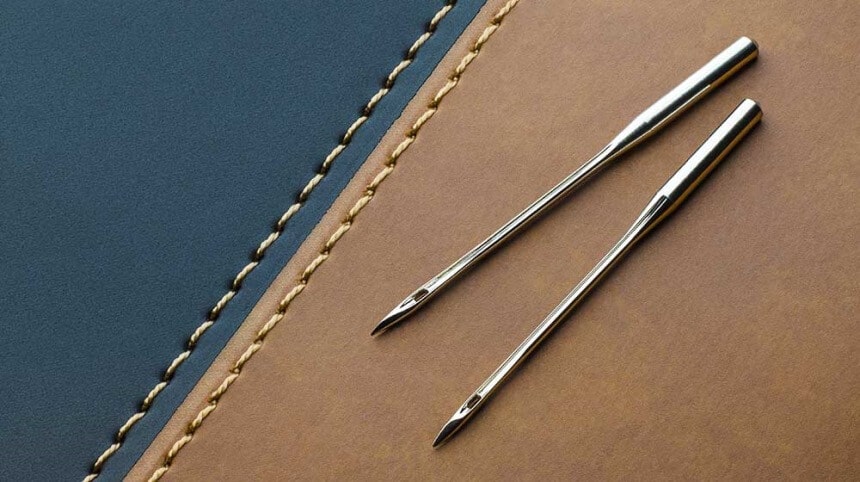
Consequently, if these threads are thicker or sourced from heavy materials, then the weight of the fabric will be much higher. In terms of density, it could be in the form of thread count, for instance, where some cotton fabrics have a thread count of 200 per square inch while others have a 500 thread count.
Thicker/heavy-duty needles tend to work better with thick heavyweight materials. The extra reinforcement helps the needle penetrate the materials without breakage. According to most reviews, the SINGER 04801 needles are some of the most reliable heavy-duty universal needles in the market. The package includes five needles with size ranges from 90/14 to 110/18, and they’re best suited for medium-weight leather, medium-weight denim, and heavyweight cotton.
On the other hand, thinner needles work better for thinner materials as well. That said, it’s somewhat difficult to classify a type of fabric as either heavyweight or lightweight. After all, some can be considered both lightweight and thick, depending on the option you buy.
In the example we’ve given above, the 500 thread count option is obviously heavier than the 200 thread count alternative, and thus you can’t use the same needle sizes for both. The same can be said of denim and other fabrics, where they are available in both lighter and heavier variations.
In addition to the weight of the fabric, there also needs equal consideration for the type of sewing thread. Larger needles, of course, work better with thicker threads and vice versa for smaller needles.
If you were to try and do it the other way round, there are bound to be some issues. For instance, if you use thicker threads with thinner needles and vice versa, this would lead to broken threads, skipped stitches, and a few other problems.
Ultimately selecting the right sewing machine needle for a project comes down to two major factors, i.e., the thickness and purpose. As we mentioned above, a thick needle is best suited for thick materials. It has the necessary reinforcement to keep it intact as it pierces through the material. Thinner needles pierce through fine fabrics without causing much damage.
As for the purpose, you can see from the list of needle types above that they’re meant for different functions. One is intended for leather, another for denim, another for quilting, another for top-stitching, and more. As such, always check to ensure the needle you pick matches the intended purpose.
| Fabric types | examples | Needle style | Needle size |
| Lightweight woven fabric | Voile, Batiste, Lightweight linen, Organza | Regular point | 80/11 |
| Lightweight stretch fabric | Jersey, T-shirt fabric, Lingerie, Tricot | Ball-point | 80/11 |
| Medium weight woven | Satin, Silk, Rayon, Quilting cotton, Wool, Medium-weight linen | Regular point | 90/14 |
| Medium weight stretch | Sweatshirt fleece, Synthetic suede, Ponte knit | Ball-point | 90/14 |
| Heavyweight woven | Burlap, Twill, Poplin, Canvas, Duck, Denim | Regular point | 100/16 |
| Heavy weight stretch | Faux fur, Double Knit, Polar fleece | Ball Point | 100/16 |

For one, if there’s a significant change in the materials you’re using, including both the fabrics and sewing threads. As we mentioned above, thick threads need to be matched with thick needles and thick fabrics. Thin threads work with thin needles and lightweight fabrics.
Also, the needle could already be damaged. Signs of damage include threads breaking, uneven stitches, skipped stitches, large holes in the fabric, and even a popping sound whenever the needle tip drives into the fabric.
Changing needles in a sewing machine is often the same for all brands and is as follows. Since the old needle can drop into the machine and cause damage, you first place a piece of paper or even fabric below the machine’s presser foot. Then you locate the needle screw that should be somewhere close to the top of the needle in the machine setup.
After that, you open the needle screw. Most sewing machine manufacturers ship their products with a screwdriver for this reason. After the old needle falls out, pick your new needle and insert it into the opening. If the flat side of the shank is not facing the backside of the machine, then the needle won’t fit. As such, ensure it’s in the right orientation and push it as far up as possible before attempting to close the needle screw.
Also, if you don’t push it all the way to the top, there are bound to be some problems with your stitches.
Getting sewing machine needle sizes right can be a complex affair and may even involve some trial and error as you’re getting into sewing. However, it doesn’t take long to get used to the different sizes, needle types, and their purposes. That said, this guide can be quite helpful before you get there. Additionally, a sewing machine needle chart like the one below can make selecting the right needle much less complicated.